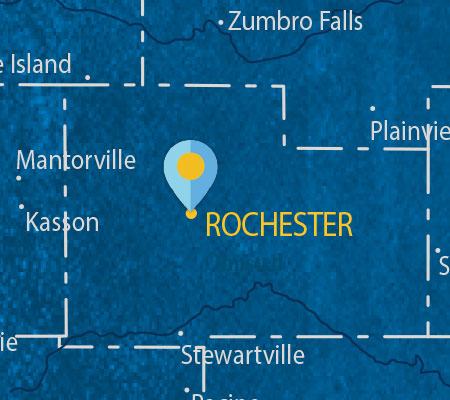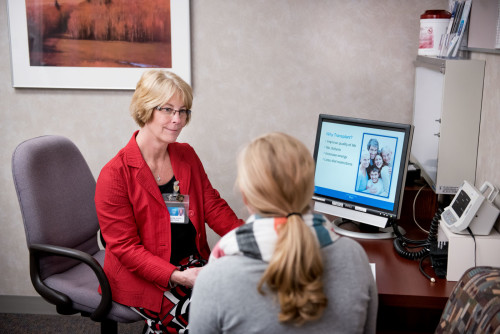
Mayo Clinic’s Living Donor Kidney Transplant Program Saving Lives

Lynette Fix, Mayo Clinic’s kidney transplant and living donor coordinator, and nursing supervisor, meets with a prospective kidney donor.
However, thanks to innovative technology from the Mayo Clinic, years of waiting may no longer be the case for a growing number of kidney transplant patients. After seeing the improved health outcomes in their patients who received a kidney transplant from a living donor, Mayo Clinic developed a Paired Donation Program.
Through this internal program, Mayo specialists find matches for people who wish to donate their kidney to someone they know but with whom they are not compatible. This creates a “donor chain,” where three or more people can be matched with donors, so if a person wants to donate a kidney to a friend but isn’t a match, Mayo will find a match for that donor and a match for the original recipient, too. The Paired Donation Program is currently being used in 20 percent of the Mayo Clinic’s kidney transplant cases.
The Paired Donation Program came out of the knowledge that the current system simply wasn’t working as well as it could. Mayo Clinic – ranked number one in the nation for nephrology by US News & World Report –realized that by matching up people willing to donate a kidney with those in need of a transplant, they may be able to help someone else, if not their immediate friend or family member. A kidney from a living donor leads to better outcomes for the patients, and those that have had a friend or family member go through a kidney transplant tend to be more willing to be on the list to donate if a match arises.
This new approach has already proven to be particularly successful. While, nationwide, 30 to 35 percent of kidney transplants are from living donors, the Mayo Clinic in Rochester boasts an astounding 75 percent living donor transplant rate for those who have received treatment and a 40 percent preemptive transplant number.
Knowing Mayo Clinic has expertise and innovative thinking in treatment for complex medical conditions, Blue Cross and Blue Shield of Minnesota (Blue Cross) worked with the organization to form the Living Donor Kidney program. Through this relationship, which recently launched with a handful of employers, Blue Cross is beginning to work with larger organizations who see the health care value that can stem from such an innovative program.
“Most providers out there aren’t thinking preemptively or upstream until that person faces dialysis,” said Shannon Nelson, senior director of collaborative care and clinical innovation for health collaboration at Blue Cross.” We felt it would be ideal to create a program with Mayo Clinic where we identify these folks and start this conversation about kidney transplant long before dialysis.”
Blue Cross and the Power of Data
In a world where “big data” is currently a catch phrase, Mayo’s Paired Donation program is a testament to the power of data.
“We have data to show that the patients who do best from a survival point of view are the patients who receive kidneys from a living donor,” said fellow Mayo Clinic transplant specialist, Dr. Mikel Prieto. “And it’s a quality of life issue for the patient. Even if you live a long time, being on dialysis is not fun. If you want to have a full, active life, the best way you can do that is by getting a kidney transplant.”
Paired with insight and data from Blue Cross, patients are identified in the earliest stage of kidney failure, before they even need to undergo dialysis and are directed to Mayo’s innovative transplant program. Mayo Clinic specialists discuss transplantation options with patients, and the benefits of living kidney donation versus relying on a long wait list for deceased donors, which can take years.

A transplant team meets at Mayo Clinic to discuss a patient case. Pictured are (from left) Katie Rose, transplant nurse manager; Lynette Fix, kidney transplant and living donor coordinator; Dr. Manuel Moreno Gonzalez, transplant surgery resident; Chenelle Hager, kidney program pre-transplant RN care coordinator; and Tammy Kozel, kidney program pre-transplant RN care coordinator.
The Paired Donation Program in Action
Under Mayo Clinic’s Paired Donation Program, patients are being asked to consider friends, family, neighbors, coworkers – anyone they know who might be willing – as a potential donor, long before they would need dialysis. Beginning the process while patients are still healthy, combined with procuring an organ from a living donor, add up to a better outcome in the long run, said Dr. Prieto.
“For example, a father wants to give a kidney to his son, but the son is 20 and the father is 60. We say, ‘Well, if you let us use that kidney for someone else who is a compatible donor, we can get you a compatible donor for your son who has a younger kidney.”
Recently, the program expanded to patients who do have compatible donors but might be able to find someone even more compatible, he added.
“As our (kidney transplant) practice has gone on, we’ve realized that a lot of these transplant patients are actually falling off because they get too sick or die before getting a donor,” said Dr. Thomas Schwab, a transplant specialist at Mayo Clinic. “Patients today are very cognizant of that and they’re looking for alternatives, and we can show them that living donation is a better option for them.”
An Evolving Process
The question still remains for how to best get a kidney from a living donor. Lynette Fix, Mayo Clinic’s kidney transplant and living donor coordinator, and nursing supervisor, said “educating and empowering patients is a huge piece of the puzzle in matching patients and donors.”
Her team takes a guided care approach to lead patients through the process – classes, phone calls, tests and even coaching them on how to find a living donor on their own.
“The biggest piece of advice I give to patients is to think about sharing their story,” she said, noting that social media had become a new avenue for doing so.
In fact, social media is such an effective tool that the kidney transplant team is in the process of creating a toolkit that provides wording for patients to easily explain their situation along with a link to place on social networking sites to provide more information.
“We think this could be a game changer in terms of a lot more people coming forward to say I’ll help my friend or my neighbor or my Facebook friend,” said Dr. Prieto. “That may dramatically change the waiting time, and the number of people who get transplants.”
Dr. Schwab added that Mayo Clinic also offers tools “where people who want to be donors can go online, 24-7, and do the preliminary screening online, so they don’t even have to make a phone call to a coordinator.”
New Approaches = Greater Savings
All of these forward-thinking processes also have the benefit of savings for health insurance providers. A transplant on a healthy individual who has not yet started dialysis alone has the potential of saving millions over a few years’ time.
Garrett Black, Blue Cross’ senior vice president for health services, provider relations and medical management, believes that the current systems leave people unable to see where the best doctors at the best prices can be found. “Right now, all people can see are grey dots on a map,” said Black.
Black explains that in reality there are some health systems that are high in cost and/or low in quality. These systems are what he refers to as “red dots”. But there are also health systems that offer the best cost for the greatest outcomes. These providers are “blue dots”.
“We want people to help people find the blue dots on the map,” Black said. “For those needing a kidney transplant, the Mayo Clinic is absolutely a blue dot health care provider. That’s where we want our members to be. That’s why we’re working together on this program.”
And patient outcomes are better than ever.
“I think most people don’t realize how successful living donor kidney transplantation is today,” Dr. Prieto said. “When people ask me the day before the surgery what are the chances it will ‘take’ or work, the answer is almost 100 percent.”
More info on Mayo Clinic’s innovative living-donor transplant program can be found at MayoClinic.org.
